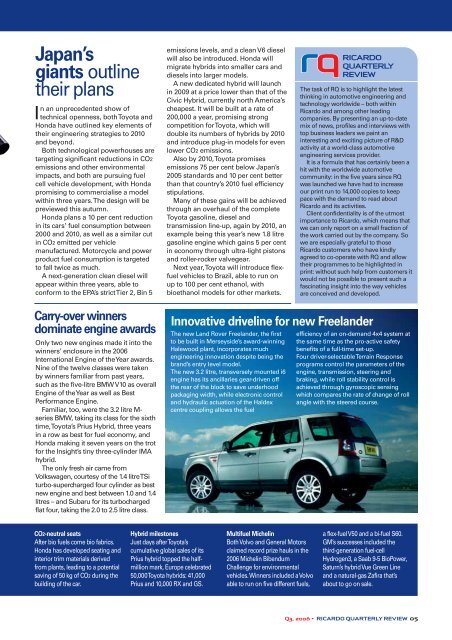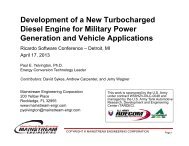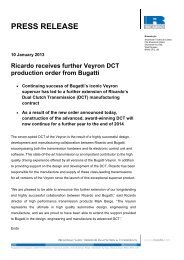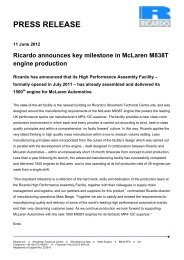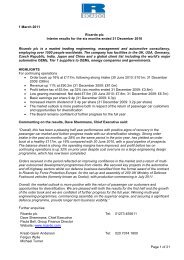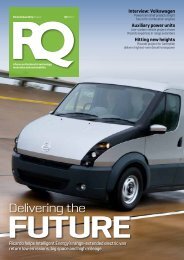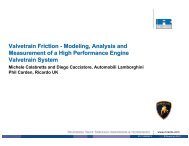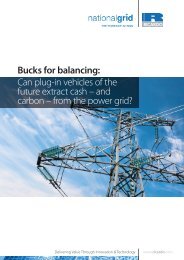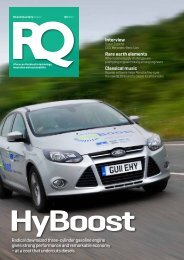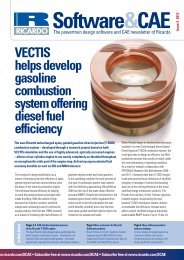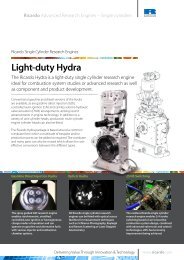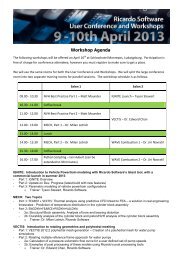The hottest - Ricardo
The hottest - Ricardo
The hottest - Ricardo
Create successful ePaper yourself
Turn your PDF publications into a flip-book with our unique Google optimized e-Paper software.
Japan’s<br />
giants outline<br />
their plans<br />
In an unprecedented show of<br />
technical openness, both Toyota and<br />
Honda have outlined key elements of<br />
their engineering strategies to 2010<br />
and beyond.<br />
Both technological powerhouses are<br />
targeting significant reductions in CO2<br />
emissions and other environmental<br />
impacts, and both are pursuing fuel<br />
cell vehicle development, with Honda<br />
promising to commercialise a model<br />
within three years. <strong>The</strong> design will be<br />
previewed this autumn.<br />
Honda plans a 10 per cent reduction<br />
in its cars’ fuel consumption between<br />
2000 and 2010, as well as a similar cut<br />
in CO2 emitted per vehicle<br />
manufactured. Motorcycle and power<br />
product fuel consumption is targeted<br />
to fall twice as much.<br />
A next-generation clean diesel will<br />
appear within three years, able to<br />
conform to the EPA’s strict Tier 2, Bin 5<br />
emissions levels, and a clean V6 diesel<br />
will also be introduced. Honda will<br />
migrate hybrids into smaller cars and<br />
diesels into larger models.<br />
A new dedicated hybrid will launch<br />
in 2009 at a price lower than that of the<br />
Civic Hybrid, currently north America’s<br />
cheapest. It will be built at a rate of<br />
200,000 a year, promising strong<br />
competition for Toyota, which will<br />
double its numbers of hybrids by 2010<br />
and introduce plug-in models for even<br />
lower CO2 emissions.<br />
Also by 2010, Toyota promises<br />
emissions 75 per cent below Japan’s<br />
2005 standards and 10 per cent better<br />
than that country’s 2010 fuel efficiency<br />
stipulations.<br />
Many of these gains will be achieved<br />
through an overhaul of the complete<br />
Toyota gasoline, diesel and<br />
transmission line-up, again by 2010, an<br />
example being this year’s new 1.8 litre<br />
gasoline engine which gains 5 per cent<br />
in economy through ultra-light pistons<br />
and roller-rocker valvegear.<br />
Next year, Toyota will introduce flexfuel<br />
vehicles to Brazil, able to run on<br />
up to 100 per cent ethanol, with<br />
bioethanol models for other markets.<br />
RICARDO<br />
QUARTERLY<br />
REVIEW<br />
<strong>The</strong> task of RQ is to highlight the latest<br />
thinking in automotive engineering and<br />
technology worldwide – both within<br />
<strong>Ricardo</strong> and among other leading<br />
companies. By presenting an up-to-date<br />
mix of news, profiles and interviews with<br />
top business leaders we paint an<br />
interesting and exciting picture of R&D<br />
activity at a world-class automotive<br />
engineering services provider.<br />
It is a formula that has certainly been a<br />
hit with the worldwide automotive<br />
community: in the five years since RQ<br />
was launched we have had to increase<br />
our print run to 14,000 copies to keep<br />
pace with the demand to read about<br />
<strong>Ricardo</strong> and its activities.<br />
Client confidentiality is of the utmost<br />
importance to <strong>Ricardo</strong>, which means that<br />
we can only report on a small fraction of<br />
the work carried out by the company. So<br />
we are especially grateful to those<br />
<strong>Ricardo</strong> customers who have kindly<br />
agreed to co-operate with RQ and allow<br />
their programmes to be highlighted in<br />
print: without such help from customers it<br />
would not be possible to present such a<br />
fascinating insight into the way vehicles<br />
are conceived and developed.<br />
Carry-over winners<br />
dominate engine awards<br />
Only two new engines made it into the<br />
winners’ enclosure in the 2006<br />
International Engine of the Year awards.<br />
Nine of the twelve classes were taken<br />
by winners familiar from past years,<br />
such as the five-litre BMW V10 as overall<br />
Engine of the Year as well as Best<br />
Performance Engine.<br />
Familiar, too, were the 3.2 litre M-<br />
series BMW, taking its class for the sixth<br />
time, Toyota’s Prius Hybrid, three years<br />
in a row as best for fuel economy, and<br />
Honda making it seven years on the trot<br />
for the Insight’s tiny three-cylinder IMA<br />
hybrid.<br />
<strong>The</strong> only fresh air came from<br />
Volkswagen, courtesy of the 1.4 litre TSi<br />
turbo-supercharged four cylinder as best<br />
new engine and best between 1.0 and 1.4<br />
litres – and Subaru for its turbocharged<br />
flat four, taking the 2.0 to 2.5 litre class.<br />
Innovative driveline for new Freelander<br />
<strong>The</strong> new Land Rover Freelander, the first<br />
to be built in Merseyside’s award-winning<br />
Halewood plant, incorporates much<br />
engineering innovation despite being the<br />
brand’s entry level model.<br />
<strong>The</strong> new 3.2 litre, transversely mounted i6<br />
engine has its ancillaries gear-driven off<br />
the rear of the block to save underhood<br />
packaging width, while electronic control<br />
and hydraulic actuation of the Haldex<br />
centre coupling allows the fuel<br />
efficiency of an on-demand 4x4 system at<br />
the same time as the pro-active safety<br />
benefits of a full-time set-up.<br />
Four driver-selectable Terrain Response<br />
programs control the parameters of the<br />
engine, transmission, steering and<br />
braking, while roll stability control is<br />
achieved through gyroscopic sensing<br />
which compares the rate of change of roll<br />
angle with the steered course.<br />
CO2-neutral seats<br />
After bio fuels come bio fabrics.<br />
Honda has developed seating and<br />
interior trim materials derived<br />
from plants, leading to a potential<br />
saving of 50 kg of CO2 during the<br />
building of the car.<br />
Hybrid milestones<br />
Just days after Toyota’s<br />
cumulative global sales of its<br />
Prius hybrid topped the halfmillion<br />
mark, Europe celebrated<br />
50,000 Toyota hybrids: 41,000<br />
Prius and 10,000 RX and GS.<br />
Multifuel Michelin<br />
Both Volvo and General Motors<br />
claimed record prize hauls in the<br />
2006 Michelin Bibendum<br />
Challenge for environmental<br />
vehicles. Winners included a Volvo<br />
able to run on five different fuels,<br />
a flex-fuel V50 and a bi-fuel S60.<br />
GM’s successes included the<br />
third-generation fuel-cell<br />
Hydrogen3, a Saab 9-5 BioPower,<br />
Saturn’s hybrid Vue Green Line<br />
and a natural-gas Zafira that’s<br />
about to go on sale.<br />
Q3, 2006 • RICARDO QUARTERLY REVIEW 05


